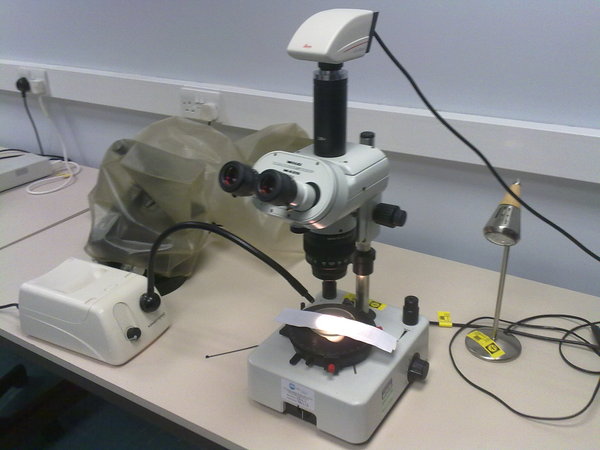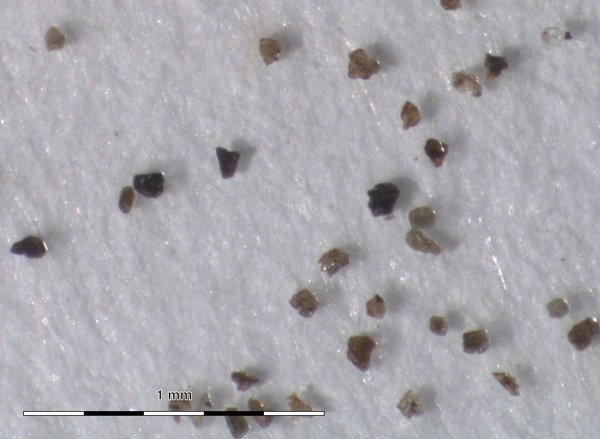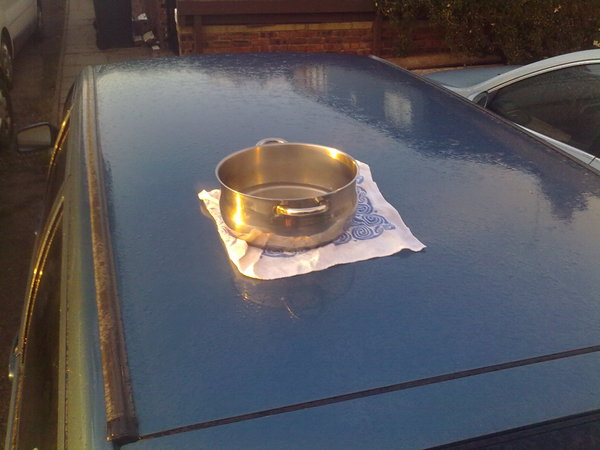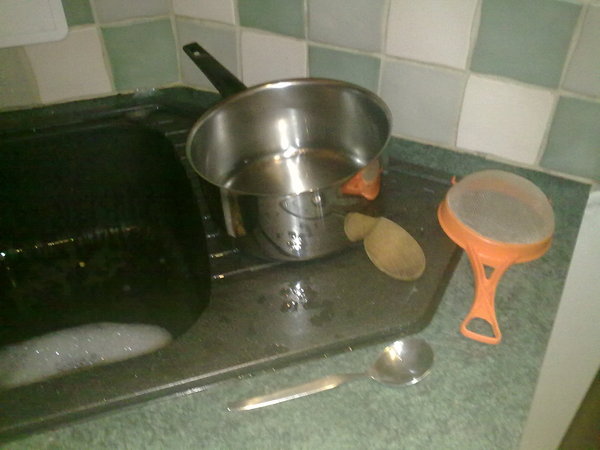Ash from the ongoing Grímsvötn eruption is predicted to arrive over the UK from Wednesday morning. At the moment it is hard to tell what it will be like. Certainly, it will not be like the scenes in Iceland where it has blanketed the ground like sandy grey snow. Perhaps it will just make the rain a bit dirty. During last year’s Eyjafjallajökull eruption, people across the UK reported ash grains in the air or grey dust spoiling their newly-cleaned cars.
It would be amazing if we could make a map of all the places in the UK where people see ash falling. The results would be extremely useful to help test the predictions of ash dispersion made by computer models. Also, ash layers from past eruptions are found in lakes and peat bogs across Europe and are used by archaeologists to correlate the ages of ancient settlements and remains. If we can measure how the ash falls in a current eruption, it will help us understand how layers from past eruptions have formed.
Coordinated sampling effort
The British Geological Survey are coordinating a nationwide collection of ash during the current Grímsvötn eruption. If ash falls where you live, then they want a sample!
A simple procedure has been put together to help you to collect a useful sample. You can read more about it on the BGS Grímsvötn Ash Collection website. It is very quick and easy. If you see ash falling, then get out your sellotape and see if you can get a sample. The following video demonstrates the method:
What the samples can tell us
The two methods of sample collection shown in the video can be used when ash is falling from the sky. The first, and easiest method, results in a paper ‘slide’ that can be looked at under a microscope.

A paper 'slide' being examined under the microscope.
If the grains are big enough, it will be possible to recognise whether they are ash or not and, using the very important information written on the paper, to make a map of where ash fell. It is important that if you decide to take a sample, that you send it in. Even if it doesn’t look like it has much on it. We also need to know where ash is not falling.

Ash grains on a paper slide can be identified based on their colour, their shape and whether they contain bubbles or small crystals. Each sample can be checked quickly to see if it contains ash. The most important information is where in the UK ash was actually falling.
The second method is a bit more complicated, but allows the samples to be examined by the Scanning Electron Microscope (SEM). An SEM can take images at over 1000x magnification, letting us see small details of the ash such has how bubbly it is. It can also show if tiny ash grains have clumped together into bigger ones, called aggregates. The SEM is even able to give us a rough idea of the chemical elements that the ash contains.

An SEM image of an 'aggregate' grain from the 2010 Eyjafjallajökull eruption. This grain fell near Loughborough. It is made of tiny particles stuck together. The grain is tiny. It is only 100 microns long, which means that 10 of these grains could fit in a millimetre. Aircraft and satellites detected grains that were even smaller.
Sampling in the rain
It’s fairly windy and rainy across the UK today and tomorrow. A lot of the ash will come down with the rain. An easy way to collect this is by putting out the biggest saucepan that you have.
- Put the saucepan on a raised platform, so that dust blowing near the ground doesn’t get in. Make sure that it has a clear view of the sky and is away from trees etc.
- Fill the saucepan with 2 cm of water. This will give it some weight to stop it blowing away, and the water will trap any particles that fall when it isn’t raining so that the wind can’t pick them up again. Leave it out until the cloud has passed (estimated to be by Thursday night).

A saucepan can be used to collect wet samples. Place it on a raised surface, away from trees. Here a car roof is used, with a towel to protect the paintwork. Putting water in the saucepan weighs it down and helps it trap ash.
- When you bring the saucepan inside, scoop any floating debris e.g. leaves/insects from the surface (a sieve is handy for this). At this stage, it might not look like you have much, but persevere as the ash grains may be very small.
- Now we need to get rid of the water. Swirl the water, then place the saucepan beside your sink, using a wooden spoon to tilt it so that ash collects along one edge. Leave it for 5 minutes; this gives all the grains time to sink to the bottom. Then use a spoon to scoop out most of the water, trying not to disturb the ash. Don’t move the saucepan. This bit is quite tricky. If you stir the water up by accident, leave it for another 5 minutes then continue.

Excess water is spooned out of the saucepan. Tilting it on a wooden spoon concentrates the ash at one side and lets you get more water out.
- The rest of the water is gently evaporated off, either by leaving the saucepan on a radiator, or by putting it in the oven at 60 deg C. The water should not boil. Depending on how much water is in the pan, this could take a few hours.
- When you are sure that things are dry, use a piece of sticky tape (~10 cm long) to ‘mop’ up all the grains.
- Stick the tape to a piece of plain white paper and label with the same information as the other tape samples (example below). Measure your saucepan, then add the following to the label: WET SAMPLE – SAUCEPAN DIAMETER XX CM. If you have lots of material, use more tape and stick it to the same paper strip.
- Send in the sample as normal.
Important information to include on label
An ash sample is useless if we don’t know where or when it was collected, or over what area. Any samples should be labelled with the following information:
Postcode (e.g. M20 4LZ)
Town: (e.g. Manchester)
Date: (e.g. 22 May 2011)
Sample collection time: (e.g. 13.00 – 21.00)
Email address: (e.g. a.b@c.com)
Extra collection information: (e.g. WET SAMPLE – SAUCEPAN DIAMETER 22cm)
The time information may need a start date and an end date.
We need data from all over the country
We need samples from all over the country, so tell all your friends. The Hebrides, the Highlands and Northern Ireland are the areas predicted to see the most ash. But don’t let that stop you if you live further from the volcano. Perhaps your town can get the record for “Furthest South” or “Furthest East” confirmed Grímsvötn ash. Also, the call for samples is not restricted to within the UK. If any ash makes it to mainland Europe, then those samples would also be extremely welcome.
Happy sampling!
(Updated 24 May, 23.21 hrs. Reason – wet sampling method added).


1. is there much point in sampling if I’m based very close to the BGS e.g. Edinburgh Nottingham?
1. would the wet method not be better even in dry weather, esp if the sampling device is out for a long time and it is a bit windy?
2. You (or was it the BGS website?) said that no ash is also important information.
In an ideal world what would your ideal sampling interval be?
I could change the sticky tape ever couple of hours during the day but with the wet method that could get a bit laborious.
Hi Stephan,
Thanks for you questions, you raise some important points.
1) Yes. In samples where the ash grains are very small it can be hard to conclusively identify ash grains. Having samples from neighbouring sites gives them context.
2) All methods have different advantages and disadvantages. The main advantage of the tape samples is that they are extremely easy to collect. This is the best way to encourage wide participation, and the main aim is to get as wide coverage as possible. Most dry sampling methods were developed for use much closer to the volcano, where it is very obvious that ash is falling.
The wet method has the big advantage of working in all weathers, and is also much better at collecting ash that falls in the rain. A lot of ash falls in the rain. The disadvantages are that it takes much more effort to collect the sample (thus decreasing the number that we can get) and that aggregate particles may break up in the water. Aggregation was a significant process in removing fine ash during the Eyjafjallajökull eruption, so it is important to sample aggregates where we can.
In an ideal world, people would have a saucepan out all week, and would collect tape samples during dry spells or if they could see ash falling. In an ideal world, I would have written this on the blog yesterday.
3) With the wet method, the sampling interval should be from now until the cloud has passed over. Most of the ash will have passed by the end of tomorrow, so Thursday night is a good time to bring them in. This might change depending on Met Office advice. Tape samples are best changed after rain, with some kind of collection going on until the cloud has passed. All the samples can be sent in together in one envelope.
Pingback: Grímsvötn 2011 (Part 2): Effects on aviation of the biggest Icelandic eruption since Katla 1918 | Volcan01010
Pingback: Grímsvötn 2011 (Part 1): UK ash deposition from the biggest Icelandic eruption since Katla 1918 | Volcan01010